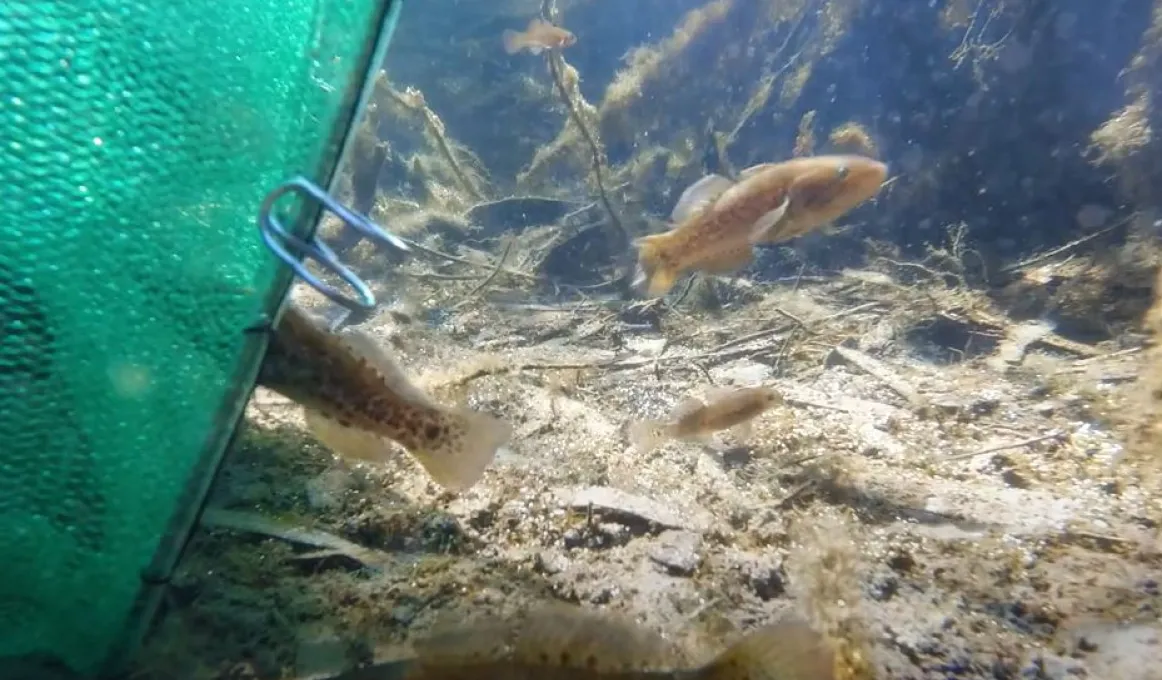Preserving the Purple Spotted Gudgeon on the Yappala IPA

The translocation of 600 hundred members of an endangered Flinders Ranges fish species from two creeks to a permanent Creek in the Yappala IPA will help to ensure the survival of the species.
Working to ensure the survival of at risk species is an important role of an Indigenous Protected Area Ranger.
The prolonged drought in the Yappala (Flinders Ranges of South Australia) has dried up many of the water holes and creeks putting at risk the native fish species, the Purple Spotted Gudgeon.
In 2021, Rob Brandle, a Senior Conservation Ecologist with National Parks and Wildlife SA and SA Arid Lands Landscape Board, approached the Yappala IPA Rangers and the local community about being involved in the Purple-spotted Gudgeon translocation. Rob engaged Mark Lethbridge from Ecoknowledge to assist in the delivery of this project.
He asked for their assistance in relocating 600 fish, by helicopter, from Weetootla Gorge and Nepouie Gorge to Hookina Creek which runs through their IPA. The goal was to increase the number of fish populations.
Roger Rigney is Coordinator of the Yappala IPA Rangers.
‘Community and the rangers were receptive and excited that they could be a part of, and participate in, such a project which not only contributed to the survival of an endangered native fish species, but more importantly a fish from their Yarta (Country),’ Roger said.
‘For community it was an honour and they are extremely proud to have played a part in the release and on-going monitoring of the fish.’
The rangers assisted in the coordination of the community participation and on-ground logistics on release day, meeting the helicopter and Ecoknowledge staff at the sites and actually releasing the fish.
‘The rangers, community and children all participated in the release of the fish into Hookina Creek. The pride and excitement overflowed when asked if they would like the honour to do so.’
The rangers are tasked with monitoring the release sites including more complex assessments which involve visits from Ecoknowledge, National Parks and Wildlife SA and SA Arid Lands Landscape Board representatives.
‘Monitoring includes general visual observation for fish at the release sites and in the creek, to gauge survival rates and breeding,’ Roger said.
‘Recent monitoring has determined that breeding has commenced which is a very important indicator the fish have taken residence in the creek system. Also due to the complexity and time some techniques to monitor take, it was decided to purchase a drone submarine for Yappala IPA.’
Ecoknowledge trained the rangers to handle the drone submarine, which will dramatically increase the efficiency of monitoring activities required in the future.
The future of the fish is assured because Hookina Creek is a permanent water source with groundwater constantly bubbling up near the release sites.
After a long drought the recent rains have greened the IPA and flushed out and replenished dried-out waterholes, but there is no plan to place fish in them, Roger said.
‘The fish are pretty hardy as you would expect being an Australian Native and with the thick congregation of rushes, the solid rocky creek bed formation/structure with deep undercuts and holes, the fish have plenty of places to hide and weather the sometimes heavy rainfall events of recent times.’
‘It is anticipated and we’re confident that the fish will establish a health insurance population at the release sites and move up and down the creek system once numbers and the population grows.’
Watch the video to learn more about the relocation effort.
Find out more
Management of the Yappala Indigenous Protected Area is supported by funding from the Australian Government’s Indigenous Protected Areas Program, administered by the National Indigenous Australians Agency.
The IPA Program allows Indigenous communities to voluntarily establish protected areas for biodiversity conservation on Indigenous-owned or managed land and sea Country through an agreement with the Australian Government.
For more information, see Ecoknowledge.